The Helgoland class Battleships were very similar to the previous Nassau, first generation of Imperial German dreadnoughts. But they were a bite more: They were a breakthrough in German battleships design, the main artillery was scaled up to 12 inches (305 mm). When these ships were completed in 1911-1912 Great Britain however just swapped to 14 inches (343 mm). Another difference with the Nassau, the four Helgoland had three grouped funnels and were much larger in size and displacement, with more output to compensate (and better speed), increased secondary armament and larger torpedo tubes. They formed the 1st squadron (Vice Admiral Von Lanz) with the Nassau class until better dreadnoughts replaced them. They took part in the Battle of Jutland but on June 1, 1916, Osfriesland struck a mine and managed to return to port safely. In November 1918, they did not followed the Hochseeflotte to Scapa Flow, and were allowed to remain in France waiting their fate, and ended broke up up in 1921-24 apart Ostfriesland famously sunk by Billy Mitchell to demonstrate air power.
Helgoland class: Much more than improved Nassau
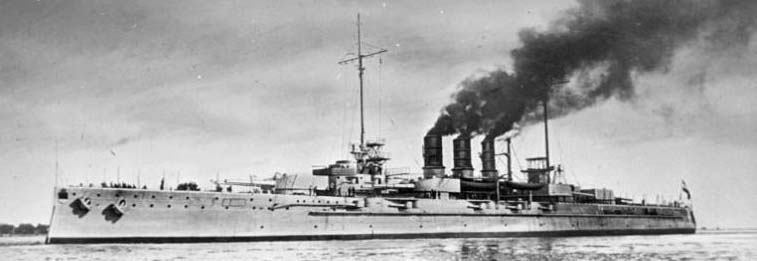
The Triple Entente (UK France, Russia) signed in 1907 saw Germany growingly isolated on the Continent and Admiral Alfred von Tirpitz’s own take on the problem was to ask for new and stronger capital ships. He wanted the Navy to do its share against the Royal Navy, denying a possible blockade while going after its own supply lines while the Army could concentrate on dealing with France ad Russia.
“The aim which I had to keep in view … for technical and organizing reasons as well as reasons of political finance was to build as steadily as possible.”
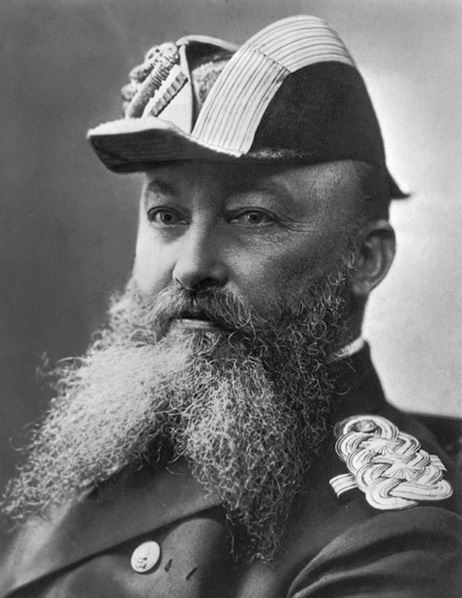 He proposed a Second Amendment to the Naval Law, and with heavy support of Kaiser Whilhelm, it was passed on 27 March 1908. The previous class, the Nassau, had been largely experimental, and still suffered the comparison with a larger main artillery in numbers, but with a repartition denying concentration of fire and with 28 cm (11 in) instead of 30 cm (12 in) main guns.
He proposed a Second Amendment to the Naval Law, and with heavy support of Kaiser Whilhelm, it was passed on 27 March 1908. The previous class, the Nassau, had been largely experimental, and still suffered the comparison with a larger main artillery in numbers, but with a repartition denying concentration of fire and with 28 cm (11 in) instead of 30 cm (12 in) main guns.
The choice of artillery
For the second class of German dreadnoughts debate raged on the design. In May 1906, the Reichsmarineamt (RMA), the Imperial Navy Office had intel from britain about new battleships in construction equipped with 13.5-inch (34 cm) guns. Essentially they were the first “super dreadnoughts”. As a result, the General Navy Department wanted urgently a step up to 30.5 cm (12 in). And yet this was amazingly resisted by Tirpitz which allegedly voices his fears about trigerring a an arms race with Britain.
Tirpitz’s hesitation however disappeared when he learned by early 1907 that the USN were entering this new race with their own 12-in armed dreadnoughts. Meanwhile, France, Italy, Asostro-Hungary also put in construction 12-in armed battleships.
The choice of arrangement
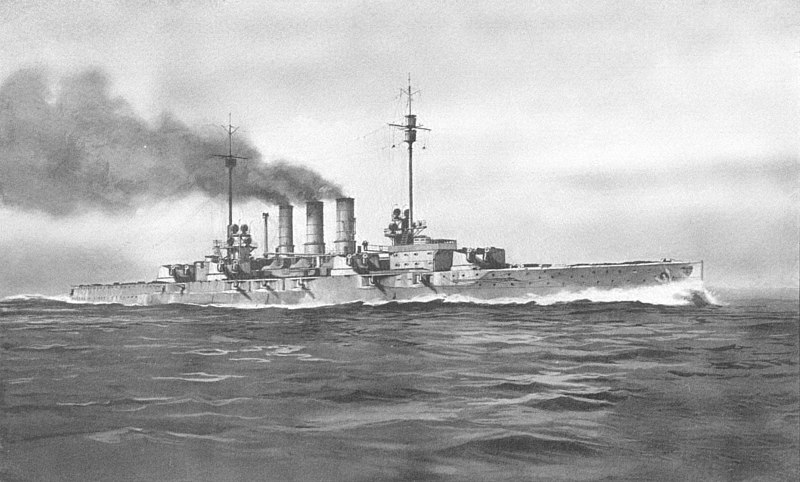
Artist depiction of Helgoland for Janes 1911
So by March 1907, Tirpitz formerly endorsed the Construction Department to start the design of a new battleship class with 30.5 cm guns, 320 mm (13 in) thick belt. The arrangement of the main battery remained a matter of debate, as it was internationally. HMS Dreadnought showed the way with three inline turrets and two wing turrets, offering a reasonably good arrangement with only ten guns, but also built in Britain, the two Minas Geraes-class battleships being built for Brazil which had two more, in échelon center and four superfiring, a more efficient arrangement. Superfiring turrets were initially favored by Tirpitz and the Helgoland class would have those, but the Construction Department at the time had the strong belief (proven false) that a single hit could disable both turrets with a single hit. They wanted the turrets being widely separated. As a result, there was no wonder why the older hexagonal arrangement of the Nassaus was retained. We can only guess how an Helgoland class, with two superfiring pairs fore and aft and an échelons pair in the center would have performed. The initial fears were later brushed aside with the next classes (seeing the bandwagon on nations adopting this configuration), with the last König class being the closest of that possible arrangement. Yet still, the all deck turrets was still a favorite by the time the Helgoland were ordered: The Italian Dante Aligheri, Russian Gangut, Spanish Jaime I, all had deck turrets. The swap for all really commenced in 1912.
Once it was established the new caliber, and similar arrangement, it was now way easier for the design bureau to have the Nassau just up-scaled. But the new design offered new possibilities. More space meant a more powerful powerplant, more range, and adding extra secondary guns.
The Naval Law was also twisted in order to authorize these new ships. Indeed the tradition accepted by the paerliament was that the new warhips were ordered at the planned retirement of older units. Thus, with the right supports, the text was modified, so as to reduce the lifespan for these capital ships from 25 years to 20 years. The Reichstag now was compelled to to allocate funds for these additional ships. The new battleships were presented as a replacement for the coastal defense ships of the Siegfried and Oldenburg classes, and the Brandenburg-class pre-dreadnoughts, now scheduled to be sold to the Ottoman Empire. The naming of older ships was retaken for some of the new units.
Tirpitz which previously failed to obtain extra ships in the First Amendment to the Naval Law of 1906 saw these now approved, and this was assorted by a 1 billion marks for extra equipments. In the end, the Reichstag endorse the replacement ptogram: The four Sachsen-class (1878) ironclads were so replaced by four Nassaus, three Siegfried-class (Siegfried, Beowulf, Frithjof) and the remaining SMS Oldenburg replaced by the new Helgoland-class. The new named Helgoland, Ostfriesland, Thüringen, Oldenburg succeed in tme to the provisional “Ersatz Siegfried”, “Ersatz Oldenburg”, “Ersatz Beowulf”, and “Ersatz Frithjof” as planned replacements.
Design of the class

3D rendition on turbosquid
The Helgoland were not just upscaled Nassau. They were the largest battleships (or warships for that matter) ever built for the German Navy. They were longer at 167.2 m (548 ft 7 in) overall with a larger beam at 28.5 m (93 ft 6 in) – instead of 26.9 m (88 ft 3 in)- and when fully loaded, had a draft of 8.94 m (29 ft 4 in). In displacement they also rose to 22,808 tonnes (22,448 long tons) standard, 24,700 tonnes (24,310 long tons) fully loaded, a cruiser-size (4,000 tonnes) difference. The hull ratio was also better, making for higher top speed.
Hull and general design

The class was also considered better sea boats than the Nassau class, they were better balanced and avoid the severe rolling of their predecessors, and their hull shapes were revised as well as the ruddern and counter-keels to make them more responsive to the helm, with even a tighter turning radius, bleeding far less speed in hard turns and swells. Hard rudder they still loss 54%, heeling at 7°, but for the Nassaus this was 70% speed and 12° heel respectively.
As for the general appareance, they looked sleek and low, presenting a smaller target. The three centered funnels was the results of internal rearrangements with heavy trunking to have the exhausts not encroaching on the turret’s baskets and ammunitions storage.
Superstructures were minimalistic: They were arrangeed around on the space left by the lozenge composition of the turrets. Right behind the forward one, was located a prismatic low structure supporting the forward conning tower, and a small bridge was located in front of it, supported by pillars. It barely cleared the roof of the turret. For a higher view, better to be in the forward observation post, armoured, and located on top of the foremast. The forward structures also hosted light 8,8 cm guns and had open bridge’s wings going over the wings turret’s barrels, unsupported. No doubt that was an awkward place when they fired.
Next came a long walkway way above the deck, running above machinery access hatches, service boats, and the two service boom cranes. The platform circulated around the three funnels as well. The Helgolands carried six service boats of various sizes and types, between the harbour cutter to yawls. The rear structure mirrored the shape of the forward one, with the aft conning tower, observation platforms, and the main projectors installed on platforms at the foot of the mainmast aft (same forward, eight in all), which lacked an obervation post. There was a main signal post light on a single platform aft as well.
Various wood plankings were used, pine for the deck, and a more precious red wood for the superstructures.
The Helgolands had two main anchors forward, port and starboard plus a smaller one at the poop, which had above a recess for chase guns.
Armour protection layout

The Helgoland-class had Krupp cemented armor and repeated the same layout as for the Nassau-class but with slight increases in thickness for the main and secondary batteries, and a far better roof for the forward conning tower.
Main armored belt: 30 cm (12 in) thick, defining the citadel between barbettes. 8 cm (3.1 in) at both ends.
Torpedo bulkhead: 3 cm (1.2 in) thick behind the belt.
Main armoured deck: 5.5 to 8 cm (2.2 and 3.1 in) thick depending on the location.
Forward conning tower: sides 40 cm (16 in), roof 20 cm (7.9 in) thick.
Aft conning tower: 20 cm (7.9 in) sides, 5 cm (2 in) roof
Main battery turrets: 30 cm faces and sides, 10 cm (3.9 in) roofs
Casemated secondary guns: 17 cm (6.7 in) enclosed space around, 8 cm gun shields.
The hull was pre-ASW defence and only comprised 17 watertight compartments and a double bottom over 86% of her lenght to defeat possible below-the belt rounds.
As customary for the time, the fear of torped boats, especially after 1905, saw her equipped with anti-torpedo nets, but they were removed after 1916, proving an hinderance in manoeuvers.
Powerplant
The Helgoland-class also returned to the same powerplant as before, with VTE (triple expansion steam engines), not steam turbines. This was a cost-based soltion as Parsons using its monopoly put a premium on these for Germany, asking for 1 million gold mark royalty fee for each one, meaning twelve million for the whole class. Trusted German-built triple-expansion engines were installed, driving three shaft. These four-cylinder engines were located in three separate engine rooms.
Each shaft was driving a four-bladed screw propeller 5.1 m (16 ft 9 in) in diameter.
These three engines groups were fed by their own separate boilers, 15 of them located by in their ows spaced, two fireboxes apiece, so a great total of 30, way more than for the Nassaus. The resulting output was thus up to 27,617 ihp (20,594 kW), for a paper top speed of 20.5 knots (38.0 km/h; 23.6 mph) but on trials, they exceeded 35,014 ihp (26,110 kW) for 21.3 knots (39.4 km/h; 24.5 mph).
As for range, they carried 3,200 tonnes (3,150 long tons) of coal, more than for the nassaus, and further improvements brought this total of an extra 197 tonnes (194 long tons) of oil in tanks near their boilers, in order to be sprayed on coal and boost the burn rate. At full fuel capacity any Helgoland class battleship could steam over 5,500 nautical miles (10,200 km; 6,300 mi) at 10 knots (19 km/h; 12 mph), meaning crossing the Baltic weast to east and back or exiting the Jade, crossing the north sea to the north atlantic, or venturing to the Mediterranean. The electrical power consisted of eight turbo-generators rated for a total of 2,000 kW (225 V).
Armament
Main: 6×2 30cm Sk/50
The Helgoland-class kept their hexagonal configuration as the twelve 30.5 cm SK L/50 guns were in six twin turrets, one forward and aft, the rest in pairs amidships. These guns used the long-trunk Drh LC/1908 mounting, improved variant of the LC/1907 and LC/1906 mounts of the Nassau class, a bit larger to accomodate the 30.5 cm barrels.
-Depression originally was −8°, elevation 13.5°, and later they were modified for −5.5° and 16° respectively
-Fired a 405-kilogram (893 lb) shell at 855 m/s (2,810 ft/s) muzzle veloicity.
-ROF 2-3 rounds per minute
-At 13.5°, range was 18,700 m (20,500 yd), later at 16° elevation, 20,500 m (22,400 yd).
-1,020 rounds total or 85 shells per gun provided.
Secondary: 14x 15 cm SK L/45
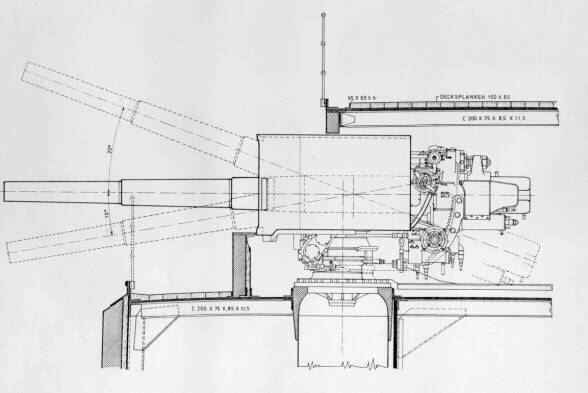
Original Skech, ctsy Peter Lienau via navweaps
The fourteen 15 cm (5.9 in) SK L/45 guns were all mounted in casemates along the upper deck.
-45.3-kilogram (100 lb) shell at 840 m/s (2,800 ft/s) muzzle velocity.
-ROF 5-7 rounds per minute.
-Elevated 19°, traverse +150/-150 degrees, range 14,950 metres (16,350 yd).
Given the height of the hull, they were often wet in heavy weather.
The SK L/45 were the mass produced 6-in guns for the Kaiserliches Marines, they were still ubiquitous in WW2, notably on armed merchant cruisers.
Tertiary: 14× 8.8 cm SK L/45 guns
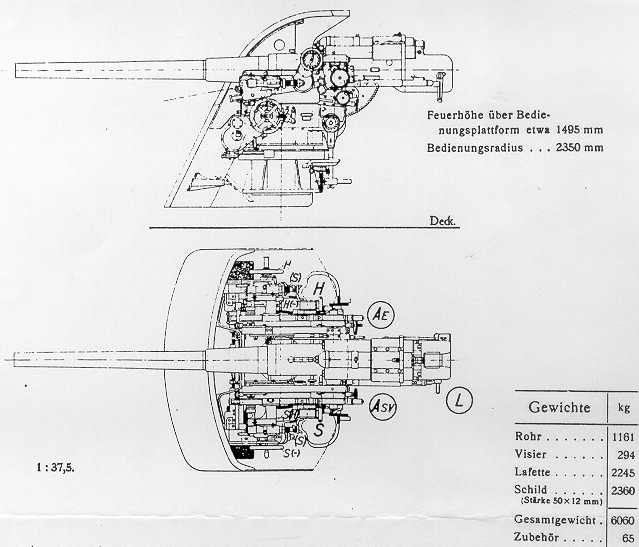
The fourteen 8.8 cm (3.5 in) SK L/45 guns were also in casemates. Four were located in either of the bridge and aft bridge under shields, upper deck. The rest were located in part in the hull, four in casemates forward (removed in WWI and plated over) and two in the stern’s recess as chase guns.
-They fired a 10-kilogram (22 lb) shell at 650 m/s (2,100 ft/s), AA: 19.8 lbs. (9.0 kg) HE 21.5 lbs. (9.75 kg) pr HE 22.05 lbs. (10 kg)
-Their travese was 25° on average, elevation on MPLC/01-06: -10/+25 degrees
-Maximum range was 9,600 m (10,500 yd).
-Rate of fire 15 rpm
It is assumed 150 or more were carrier per gun.
Modifications:
After 1914, two 8.8 cm guns were removed, replaced by two 8.8 cm Flak guns. In 1916-1917, the remaining twelve 8.8 cm were removed. The new anti-aircraft guns fired a slightly lighter 9.6-kilogram (21 lb) shell at 770 m/s (2,500 ft/s), and at 45° could reach aircraft at 11,800 m (12,900 yd).
TT: 6× 50 cm G7
Anoter novelty compared to he Nassau class were the six 50 cm (19.7 in) G/6D submerged torpedo tubes, instead of 45 cm: One in the bow, one in the stern, two on each broadside, on either ends of the torpedo bulkhead, in a typical lozenge configuration. The better G/7 entered service in 1913. The G/6 was used before (1911).
The G/6 measured 236 in (6 m) and carried a 353 lbs. (160 kg) TNT/Hexanitrodiphenylamin (Hexanite) mixture on the G/6 and 362 lbs. (164 kg) on the G/6D
Speed was 2,410 yards (2,200 m)/35knots and 5,470 yards (5,000 m)/27 knots setups
They were powered by a Decahydronaphthalene (Decalin) Wet-Heater, kerosen on the G/6 D.
Author’s illustration of the Helgoland
⚙ specifications |
|
| Displacement | 22,808 t standard, 24,700 t FL |
| Dimensions | 167.20 x 28.50 x 8.94 (548 ft 7 in x 93 ft 6 in x 29 ft 4 in) |
| Propulsion | 3x shafts VTE, 15× water-tube boilers 28,000 PS (28,000 ihp) |
| Speed | 20.5 knots (38.0 km/h; 23.6 mph) |
| Range | 5,500 nmi (10,200 km; 6,300 mi) at 10 knots (19 km/h; 12 mph) |
| Armament | 12× 30.5 cm, 14× 15 cm, 14× 8.8 cm, 6× 50 cm TTs |
| Protection | Belt 300 mm, Decks 63 mm, Barbettes 300 mm, Turrets 300 mm |
| Crew | 42 officers + 1071 enlisted men |
Read More/Src
Books
Conway’s all the world fighting ships 1906-1921, Campbell, N. J. M. & Sieche, Erwin (1986). “Germany”.
Dodson, Aidan (2016). The Kaiser’s Battlefleet: German Capital Ships 1871–1918. Barnsley: Seaforth Publishing.
Grießmer, Axel (1999). Die Linienschiffe der Kaiserlichen Marine: 1906–1918; Konstruktionen zwischen Rüstungskonkurrenz und Flottengesetz 1906–1918; Bernard & Graefe Verlag.
Gröner, Erich (1990). German Warships: 1815–1945. Vol. I: Major Surface Vessels. NIP
Halpern, Paul G. (1995). A Naval History of World War I. NIP
Hore, Peter (2006). Battleships of World War I. London: Southwater Books.
Philbin, Tobias R. III (1982). Admiral Hipper: The Inconvenient Hero. JB Publishing Company.
Staff, Gary (2006). German Battlecruisers: 1914–1918. Oxford: Osprey Books.
Staff, Gary (2010). German Battleships: 1914–1918. Vol. 1: Deutschland, Nassau and Helgoland Classes. Osprey Books.
Tarrant, V. E. (2001) [1995]. Jutland: The German Perspective. Cassell Military Paperbacks.
Dodson, Aidan; Cant, Serena (2020). Spoils of War: The Fate of Enemy Fleets after the Two World Wars. Seaforth Publishing.
Koop, Gerhard & Schmolke, Klaus-Peter (1999). Von der Nassau – zur König-Klasse. Bernard & Graefe Verlag.
Links
on en.wikipedia.org
navweaps.com/ 88mm-45_skc13.php
navweaps.com 15cm 45_skc16
navweaps.com 12in/50 skc12
deutsche-schutzgebiete.de/
more photos on commons.wikimedia.org/
Videos
Model Kits
The Helgoland class had been covered by Armo 1:700, Combrig 1:700, and that’s about it. Not a popular one.
on scalemates.com/
3D
On https://cults3d.com/en/3d-model/game/sms-helgoland-1-2000-1-2400, low resolution of 1/2000 wargaming
The Helgoland in action
 Helgoland
Helgoland
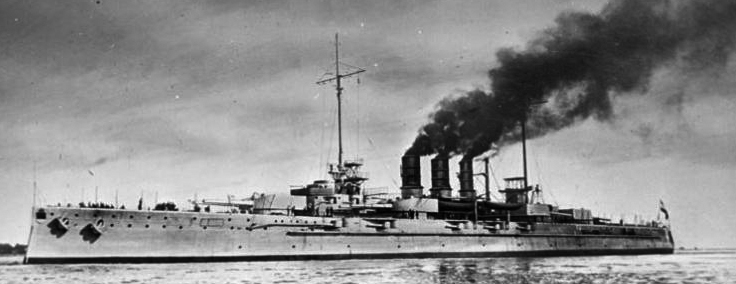
SMS Helgoland was ordered as Ersatz Siegfried, laid down at Howaldtswerke in Kiel as #500 on 24 December 1908, launched 25 September 1909, fitted-out by August 1911 and commissioned on 23 August 1911 after three years.
She replaced the pre-dreadnought SMS Hannover in I Battle Squadron and by 9 February 1912 her crew managed to beat the rcord of fastest coal loading, 1,100 tons in two hours, previouly own by Posen. In March she was in fleet training maneuvers, North Sea and later sailed ti the Skagerrak and Kattegat in November. 1913 followed the same but she cruised to Norway in summer.
On 10 July 1914, Helgoland left the Jade for her annual summer training cruise to Norway, joined by a fleet of U-Boats assembled at Skagen on the 12th to simulate TB attacks. She was in the Fjord of Songe on 18 July, guided by night by a pilot, and there joined SMS Friedrich der Grosse, Magdeburg, and the yacht Hohenzollern, in Balholm. Later she was joined by sister Oldenburg, and they cruise back home on 22 July. On 1 August, however announcement were done on preparing confrontation with the Russian Navy.
Still part of the I Division, I Battle Squadron, SMS Helgoland was stationed near Wangerooge on 9 August. Minefields, picket ships and U-Boats were placed off Wilhelmshaven. Helgoland her had powerplant active at all times and on 13 August she recoaled at Wilhelmshaven, her crew being completed by naval reservists.
Her first action was the Battle of Helgoland Bight, on 28 August 1914. She was still off Wangerooge but was not called to help the cruisers, staying as backup, anchor dropped and weiting for her sister Thüringen. Order came at 04:30, to join Ostfriesland and joined the embattered cruisers Frauenlob and Stetti but they withdrawn at 07:30 for the night. On 31 August, she entered the drydock. On 7 September, she cruised off her namesake island, Helgoland.
Next she “took part” in the raid on Scarborough, Hartlepool and Whitby on 15–16 December 1914. The I Scouting Group was to be supported, distant, by Hipper’s battlecruisers while the battleships of Friedrich von Ingenohl, was stationed in the middle of the North Sea, just 130 miles east of Scarborough for an ambush.
But the RN had the German code books captured and sent Beatty’s 1st Battlecruiser Squadron, the 2nd Battle Squadron (6 battleships), and cruisers/destroyers to catch Hippe’s battlecruisers. The battle developed but Admiral Ingenohl could not risk his fleet without order and was ordered to the southeast. Eventually her returned to the safety of German fortified bases.
On 17 January, Helgoland was in maintenance, and on 10 February joined the I Squadron off Wilhelmshaven, to Cuxhaven in heavy fog, proceeing through the Kiel Canal and later proceeding to gunnery training, torpedo firing practice in March, night-fighting training and on the 10th went back to Wilhelmshaven.

Helgoland in drydock, Kaiserliche Werft, Kiel.
The Helgoland and Nassau classes were the assigned to the Gulf of Riga task force by August 1915, under command of Hipper, with the battlecruiser Von der Tann, Moltke, and Seydlitz, light cruisers, destroyers and minesweepers. They had to deal with minefields and the pre-dreadnought battleship Slava. Helgoland remained i distaht support well off the gulf during the operation. Only Nassau and Posen were detached on 16 August with the minesweepers and to engage Slava but failed to sink her. After Russian minefields were cleared, the flotillz went further until warned of British subs in the area, and the whole fleet withdrew.
The most serious test for Helgoland and her sisters was of course the battle of Jutland. She was under command of KsZ von Kameke as part of the I Battle Squadron. She was in the center of the line of battle behind Rear Admiral Behncke’s III Battle Squadron, with Rear Admiral Mauve’s II Battle Squadron behind.
Helgoland and sisters fired the first shots at 18:00 when sailing northward, finishing off the damaged destroyers HMS Nomad and Nestor. The latter by main and secondarirs from Helgoland, Thüringen. By 19:20, Helgoland spotted and fired on HMS Warspite, and other ships of the British 5th Battle Squadron chasing the battlecruisers. Vibility was poor and the fight was short. Helgoland only spent 20 shells and by 20:15, she received during a brief lull a 15-inch (38 cm) AP from Barham or Valiant forward, hitting her armored belt 0.8 m (32 in) above the waterline and broke up on impact, and still holing her on 1.4-meter (4 ft 7 in) with splinters hitting the port side 15 cm gun and flooding her with 80 tons of seawater.
By 23:30, the formation was inverted, with the four Nassau-class forward, then Helgolands, Kaisers and Königs. At midnight on 1 June, Helgoland and Nassaus were now in the center and got contact with the British 4th Destroyer Flotilla. Helgoland and Oldenburg when spotting them a second time opened fire on leading British destroyers, Helgoland firing six secondary guns salvos at HMS Fortune and another unidentified destroyer. Torpedoes were launched but spotted, and dodged by turning to starboard.
Back in home waters, Helgoland and Thüringen took up defensive positions in the Jade roadstead. Damage reports for Helgoland was a single 15-inch impact, no dead or wounded. She was still drydock until 16 June. In all she fired 63 main battery shells, 61 rounds secondaries.
After Jutland, activity was decreased fo the German Navy. Unrestricted U-boat warfare resumed and all efforts were put in this new asset. Meanwhile the battlefleet made two abortive sorties in August and October 1916. By April 1917, Helgoland accidentally rammed the new battlecruiser Hindenburg when leaving berth, fitting-out. By October 1917 Helgoland and Oldenburg joined the cruisers Brummer and Bremse after a raid on a British convoy to Norway. On 27 November she was sent to the Baltic, kept in reserve during the occupation of the islands in the Gulf of Riga. By April 1918, she was in another failed sortie, cancelled because of engine issues with the battlecruiser Moltke.
Helgoland and sisters was scheduled to attack the British Grand Fleet a last time under Großadmiral Scheer for bargaining better terms in the armistice. However the crews were contaminated by revolutionary ideas. War-weary sailors on 29 October 1918 mutinied when ordered to sail to Wilhelmshaven, many deserting during the night, notably on Thüringen. On 30th, Helgoland’s crew seeing what happened on Thüringen, joined in the mutiny. Officers were allowed to leave unharmed but the ships were now in control of sailor’s commitees. Two torpedo boats arrived and the crews surrendered, taken ashore and incarcerated. By 5 November in addition to insurrection in the city, the red flag was raised on camital ships in Wilhelmshaven, including Helgoland. A sailors’ council took control of the base.
The Treaty of Versailles, had the four Helgoland-class battleships not sent to Scapa Flow and by 21–22 November 1918, Helgoland steamed to Harwich to gather crews of surrendered U-boats and back home she was decommissioned on 16 December 1918, stricken on 5 November 1919, formally handed over to UK on 5 August 1920 and sold for scrap at Morecambe, BU from 3 March 1921. Her coat of arms is now at the Military History Museum of the Bundeswehr in Dresden.
 Ostfriesland
Ostfriesland
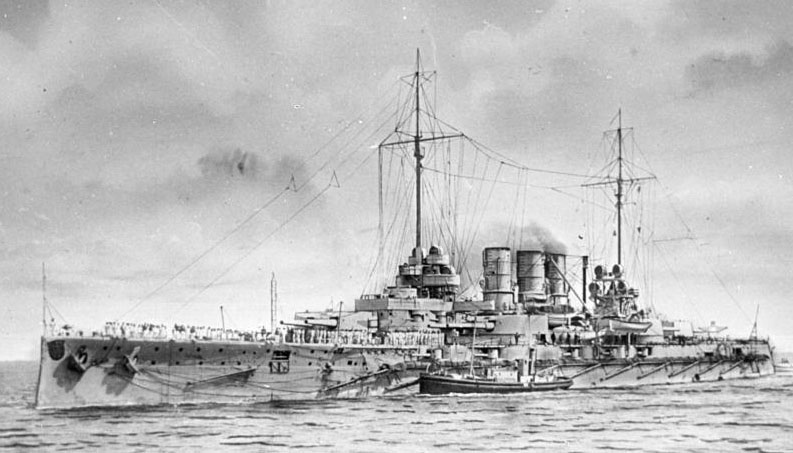
Ostfriesland was ordered as Ersatz Oldenburg, laid down at Kaiserliche Werft in Wilhelmshaven as hull 31 on 19 October 1908, launched 30 September 1909 and completed/commissioned by by August 1911.
After sea trials until 15 September with her first captain, Kapitän zur See (KzS) Walter Engelhardt she was assigned to I Battle Squadron and soon followed a routine of individual and fleet training exercises, notably maneuvers in November. She became the squadron flagship on 24 April 1912 and took place in the Norway cruise by July–August, until interrupted by the Agadir Crisis.
She also trained in the Baltic and won the 1912/1913 Kaiserschiesspreis for her marksmanship, at the head of the Squadron. By 14 July 1914, the annual summer was interrupted by drills off Skagen and while back to Germany, the fleet learned about the events and upon arrival, were prepared for war. On 29 July she was in Wilhelmshaven.
She took part in the Battle of Helgoland Bight on 28 August, while stationed off Wangerooge island. Sje joined Ostfriesland and at 05:00, the two battleships met the retreating Frauenlob and Stettin. At 07:30, they were amm nack to port and on 7 September, Ostfriesland was in training off Heligoland. In October she received 8.8 cm flak guns. She also took part in the first sortie in the North Sea on 2–3 November 1914, a sweep with no encounter.
A second on 15–16 December was ordered by Admiral Friedrich von Ingenohl, and this time Hipper’s I Scouting Group was to raid British coastal towns in order to lure out the Grand Fleet. On 15 December, Scarborough, Hartlepool, and Whitby were targeted and the German battle fleet closed to 10 nmi (19 km; 12 mi) of an isolated squadron of six British battleships but Ingenohl under orders of Kaiser Wilhelm II to avoid risks, broke off.
Next was the Battle of Dogger Bank, when Ostfriesland with the I Squadron sortied to helped the chased battlecruisersbut they failed to meet the British forces and withdrew in the Jade by 19:05. This was costly as Blücher was sunk and Seydlitz badly damaged. Furious, the Kaiser replaced Ingenohl by Admiral Hugo von Pohl on 2 February 1915.
The I Squadron battleships were ordered to the Baltic on 22 February 1915 for training until 13 March. They took part in fleet sweeps on 29–30 March, 17–18 April, 21–22 April, 17–18 May, and 29–30 May. Ostfriesland returned to the Baltic for maneuvers later. KzS Ernst-Oldwig von Natzmer took command when she was sent as distant support during the operation agains the Gulf of Riga in August 1915.
She was not involved and the fleet withdrew on 26 August to Wilhelmshaven. 23–24 October, under Admiral Pohl, saw another sweep, but again without results. By January 1916 an ill Pohl was replaced by Vizeadmiral Reinhard Scheer in January. The latter was more aggressive and under approval from the Kaiser prepared a massive sweep into the North Sea on 5–7 March, the two more on 21–22 March and 25–26 March. The latter saw Ostfriesland supporting a raid on the coast on 24 April 1916 by battlecruisers. Lowestoft was bombarded by there was opposition at Yarmouth, with the Harwich Force, however reports of British submarines had the whole I Scouting Group retreating.
Like her sisters, the greatest test of her career was at Jutland. Ostfriesland was the lead ship in I Squadron, I Division, ninth ship in the line astern of SMS Friedrich der Grosse, followed by Thüringen. They were at the center of the German line with the König and Kaiser-classes (III Squadron) forward. The battle started with battlecruisers at 16:00. Indefatigable, Queen Mary, were lost the the I scoutnung group as planned retreated to draw Beatty on the High Seas Fleet. At 17:30, König in the lead spotted the I Scouting Group and 1st Battlecruiser Squadron and at 17:45, Scheer ordered a two-point turn to port and opened fire. Ostfriesland engaged the 2nd Light Cruiser Squadron. Ostfriesland, Kaiser, and Nassau engaged HMS Southampton, and Ostfriesland shifted to HMS Birmingham and Nottingham with little luck. Ar 19:15, she spotted and fired at Warspite from 10,800 to 15,000 yd (9,900 to 13,700 m), claiming hits.
By 20:17, combat with the Grand Fleet was broken by a 180-degree turn covered by a charge by the battlecruiser squadron plus torpedo-boat attack. Schmidt ordered Ostfriesland to turn immediately, not waiting for Thüringen, disrupting a bit manoeuvers, until ships were back to their stations.
The ships headed for home in night cruising formation, SMS Ostfriesland wasbeing the eighth in line on the 24-ships and later clashed episodically with British light forces. At 01:10, she spotted and engaged the armored cruiser Black Prince, illuminated by Thüringen but Ostfriesland engaged the cruiser with her 15 cm guns. The Hochseeflotte managed to break through British destroyers and reached Horns Reef at 4:00 on 1 June but at 06:20, Ostfriesland struck a mine, laid by from HMS Abdiel on 4 May. It exploded starboard ans the captain firstr believed it to be a torpedo by a submarine. Ostfriesland fell behind the line and at slow speed was escorted by destroyer V3, V5, accelerating at 10:40 to 15 knots and signalled later underway by a floatplane, a British submarine at 12:20. Ostfriesland turned away but her torpedo bulkhead was torn open and flooding caused a 4.75 degree list to starboard. At 14:45 the flooding was under control and she passed the Jade Lightship, entering the roadstead at 10 knots (19 km/h; 12 mph) to Wilhelmshaven. In drydock she was patched for the 40 ft × 16 ft (12.2 m × 4.9 m) gap, pumped out of 500 t of seawater when drydocked in Wilhelmshaven until 26 July. At Jutland she fired 111 rounds main, 101 secondaries, even one 8.8 cm round at a destroyer. The mine blast killed one, wounded ten.
On 18 August 1916, she was called in distant support fir the raid on Sunderland. On 25–26 September, same, for a raid on the Terschelling Bank by Torpedobootes. And on 18–20 October, to the Dogger Bank. 1917 saw Ostfriesland in guard duty, German Bight. Operation Albion (Gulf of Riga) saw her in the Danish straits in blockade. On 28 October she was in Putzig Wiek, Arensburg and the operation was completed so she proceeded back to the North Sea. March 1918 saw KzS Hans Herr taking command before another, last sortie on 23–24 April 1918: Ostfriesland, Thüringen, and Nassau were deployed together for Operation Schlußstein, planned occupation of St. Petersburg. The operation was postponed and canceled and she was back in Wilhelmshaven.
She was mobilized for a final fleet action by October 1918, but on 29 October 1918, whe ordered to sail to Wilhelmshaven the night saw widespread mutiny, so the operation was cancelled. It seems mutiny was limited on Ostfriesland but on 16 December, she was decommissioned, used as a barracks ship.
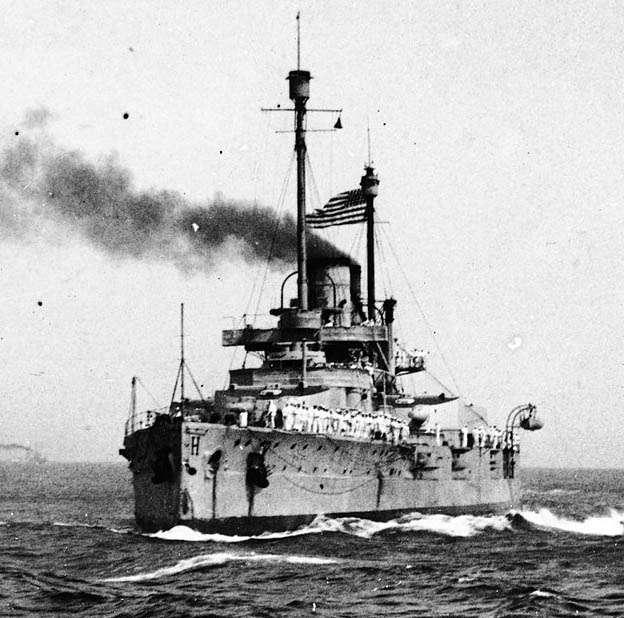
USS Ostfriesland, en route to the US
While the fleet was interned at Scapa Flow the four Helgoland-class stayed in Germany and by 21 June, learned about the scuttling. KzS Karl Windmüller became Ostfriesland’s last captain until stricken on 5 November 1919. She became the war prize “H” in Germany until 7 April 1920, then Rosyth, ceded to the United States and recommissioned on 7 April as “USS Ostfriesland” under Captain J. F. Hellweg and sailed to the US on 9 April with American crew a few german officers advisors. She headed for New York, decommissioned on 20 September 1920 but by July 1921, the USN and Army Air Service took her for bombing tests off Cape Henry under General Billy Mitchell. She was part of a “fleet” comprising the USS Iowa, cruiser Frankfurt on 20 July. The first attack at 13:30 was with 230 lb (100 kg) bombs and eight of 32 bombs dropped hit her after inspection. The second wave followed, the a third and fourth with 600 lb (270 kg) bombs. Five of the latter found their mark and she had near-hits which damaged her hull, starting a flooding, list of 5° degrees to port.
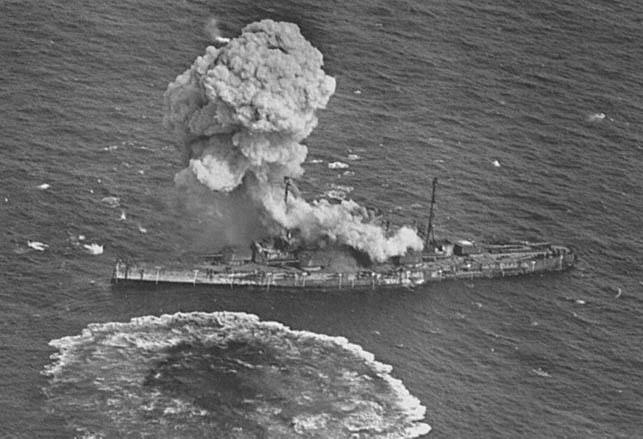
Mitchell’s test. Sge only was sunk by gradual flooding mostly resulting from near-misses.
Thus resumed on 21 July, with a fifth wave of bombers, at 08:52 (this time with 1,000 lb (450 kg) bombs). She had a hit, then two in a 6th wave. Inspection revealed they still not seriously damaged her, albeit more flooding. By noon she was five feet lower. At 12:19 she was hit with 2,000 lb (910 kg) bombs, not direct hit but only near-misses. At 12:30 flooding was such she sank rapidly by the stern, listed to port until rolling over at 12:40.
 Thüringen
Thüringen
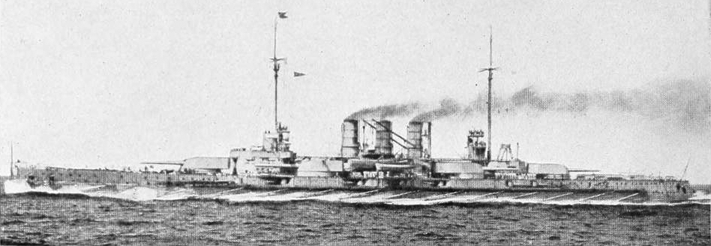
SMS Thüringen was started as Ersatz Beowulf at AG Weser dockyard, Bremen, hull 166, laid down on 2 November 1908, launched 27 November 1909 and completed in June 1911 and floated down the Weser River to the North Sea, commissioned on 1 July 1911 and starting her sea trials unti 10 September.
On 19 September, she joined I Battle Squadron and her training exercises routine started (fleet maneuvers in November, Norway cruise in summer, Baltic training). By October 1913 her new captaon was William Michaelis, until February 1915. By July 1914 she was off Skagen. On 27 July, the fleet assembled off Cape Skudenes as tension rose, and sailed to Wilhelmshaven. She was there for the first sortie in the North Sea on 2–3 November 1914, no encounter. Next was on 15–16 December for a raid on Scarborough, Hartlepool, and Whitby. She came to 10 nmi (19 km; 12 mi) of a sqn. of British battleships but Ingenohl withdrew.
During the Battle of Dogger Bank Thüringen sortied as reinforcement, but came too late and was back at 19:05 to the Schillig Roadstead. As part of I Squadron she was sent to the Baltic on 22 February 1915 for training until 13 March and back to Wilhelmshaven, took part in several sorties on 29–30 March, 17–18 April, 21–22 April, 17–18 May, and 29–30 May. Next she was mobilized for the operation in the Gulf of Riga by August 1915 but she stayed outside the Gulf, only Nassau and Posen being detached on 16 August.
On 23–24 October, she made another undruitful sorties, as well as on 5–7 March, 21–22 March, 25–26 March and 24 April 1916, aborted when Seydlitz struck a mine and later reports of British submarines. Like her sister her only serious test was at the Battle of Jutland.
Thüringen was the second ship in I Division, I Squadron, 10th in line astern of flagship Ostfriesland, ahead of Helgoland, center of the line with the König-Kaiser ahead of them. At 17:30, König, spotted I Scouting Group and the 1st Battlecruiser Squadron and at 17:50 Scheer ordered to open fire. Thüringen was too far out of range and concentrated on the British 2nd Light Cruiser Squadron. Thüringen and Kronprinz engaged HMS Dublin in poor visibility, between 18,600 to 20,800 yd with 39 shells of 30.5 cm spent for Thüringen, and later engaging the The British destroyers Nestor and Nomad. At 19:15, they spotted and engaged HMS Warspite and she opened fire on her at 19:25 with her main and secondares at 10,600-11,800 yd, sendig 21 main, 37 secondary shells in 5-6 minutes before loosing sight, making no apparent hit. Next was HMS Malaya, 20 main without hit in 7 min. at 14,100 yd (12,900 m) before turning away as ordered by Scheer to disengage.
At 23:30, while in night-cruising formation, Thüringen was 7th in line and duelled with British light forces in short and fiece engagements under projector lights. Thüringen illuminated one of these ships the lost HMS Black Prince, and fired at point-blank range. The first salvo blown overboard her aft gun turret. In total she sent 10 main, 27 secondaries, even 24 8.8 cm rounds and was not alone, until Black Prince blew up and sank in seconds. Later she engaged the destroyer Turbulent between star shell and light artillery. Like the rest she arrived at Horns Reef by 04:00, 1 June. In all she fired 107 main, 115 secondary, 22 tertiary shells and her crew had not even a single casualty.
On 18 August Scheer launched another sortie with remaining Moltke and Von der Tann, three dreadnoughts on Sunderland, Thüringen in distant cover. But the operation was aborted. On 25–26 September, Thüringen was again in cover of the torpedo-boat flotillas operating to Terschelling Bank. There was another sortie on 18–20 October to the Dogger Bank. But the battleship stayed at port for the whole of 1917, with tours of guard duty in the German Bight. Operation Albion (Gulf of Riga) she was guarding the Danish straits. Her last sortie was on 23–24 April 1918 (Operation Schlußstein), abortred. For the last action plenned on October 1918, there was mutiny: In the night of 29 October, sailors on Thüringen deserted, stokers turned off the boilers, going on strike. The loyalist torpedo boats B110 and B112 and U-135 threatened her, and some 314 sailors and 124 stokers were arrested, placed in custody. But the mutiny spread throughout the fleet until the operation was cancelled.
Not sent to Scapa Flow, Thüringen remained in Germany and was decommissioned on 16 December 1918, used as barracks until stricken on 5 November 1919. She was later allocated to the French Navy on 29 April 1920 as “L” and brought to Cherbourg by a skeleton crew, used as a target ship and sank off Gavres, partially BU there on 1923–1933, the rest rotting up for decades.
 Oldenburg
Oldenburg

Oldenburg at berth, visited by Kaiser Wilhelm II and admirals.
SMS Oldenburg was ordered as Ersatz Frithjof, laid down at Schichau-Werke, Danzig as hull 828 but delayed to 1909 in fiscal year alsthough the contract was given before the 1909 budget had been approved, and British spies being present when the yard stockpiled materials, prompted a naval scare in Britain with the famous “we want eight and we won’t wait” followed by a major escalation in the naval arms race. Her keel was laid down on 1 March 1909 she was launched on 30 June 1910 and after launching, she was fitted-out in Kiel by August 1911, commissioned on 1 May 1912 followed by sea trials in the Baltic.
On 17 July she joine the I Battle Squadron for the same training routine as her sister until July 1914, when she was hurriedly ordered back home. On 27 July she was off Cape Skudenes and two days later in Wilhelmshaven. She took part in the first sortie of 2–3 November 1914, then 15–16 December on Scarborough, Hartlepool, and Whitby. She arrived too later after the Battle of Dogger Bank, followed by training between 22 February to 13 March 1915 in the Baltic, sorties on 29–30 March, 17–18 April, 21–22 April, 17–18 May, and 29–30 May, the Gulf of Riga operation as distant support, the 23–24 October sortie, last under Von Pohl, then under Scheer on 5–7 March, 21–22 March, 25–26 March and the raifd of 24 April 1916 cancelled after Seydlitz hit a mine to Yarmouth. Next was the Battle of Jutland in which SMS Oldenburg was the fourth in her own class in line, 12th overall astern of Helgoland, ahead of Posen of the next Nassau class.
This get serious at 17:00, but she only commenced firing at 18:30, on the destroyers Nestor and Nomad. At 19:15, she fired on Warspite but briefly during an ordered 180-degree turn to disengage, claiming hits.
23:30, and she was the fifth in line when back home. At 01:10, six destroyers (4th Destroyer Flotilla) were spotted and engaged, Oldenburg firing at close range, notably on Fortune and Porpoise. She took a single 4-inch hit at her forward searchlight above the bridge and this killed and wounded most officers of the bridge including the helmsman and Captain Höpfner. Unsteered, she nearly rammed Posen and Helgoland until Höpfner reached the wheel, took control. Next her gunners engaged HMS Ardent and later Fortune was sunk.
Like the rest she reached Horns Reef by 4:00, 1 June and entered the Jade for repairs. In all she fired 53 main, 88 secondaries, 30 tertiary shells, and the single lucky hit from HMS Fortune was the only damage she ever had in this was, albeit she had a misfire in the N°4 port-side 15 cm gun, adding casulaties, which amounted to 8 men killed, 14 wounded, mostly officers including the captain.
After guarding the German Bight, repairs in Wilhelmshaven (30 June-15 July) she was mobilized for a sortie on 18 August, on Sunderland later cancelled. There was also an aborted sortie on 25–26 September, to the Terschelling Bank and on 18–20 October (Dogger Bank) but this was a quiet 1917, while for Operation Albion she was posted in the Danish straits. Last sortie was on 23–24 April 1918, aborted after Moltke suffered engine troubles. For the final fleet action of October 1918, mutiny was in the air. On 29 October, sailors on Thüringen followed the move, the last sortie was cancelled. Oldenburg was stricken on 5 November 1919 and after the Treaty of Versailles, she was surrendered to Japan as “M” on 13 May 1920 but sold to a British shipbreaker by June 1920 BU in Dordrecht.

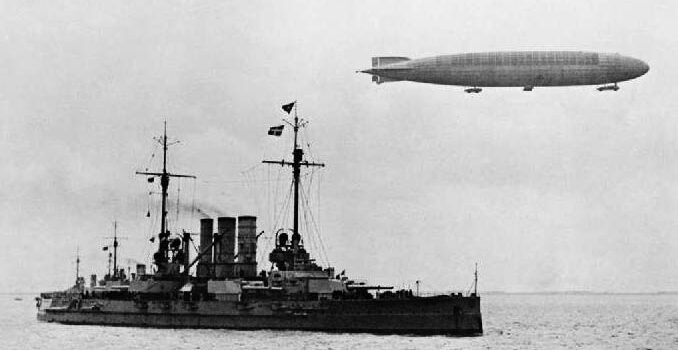

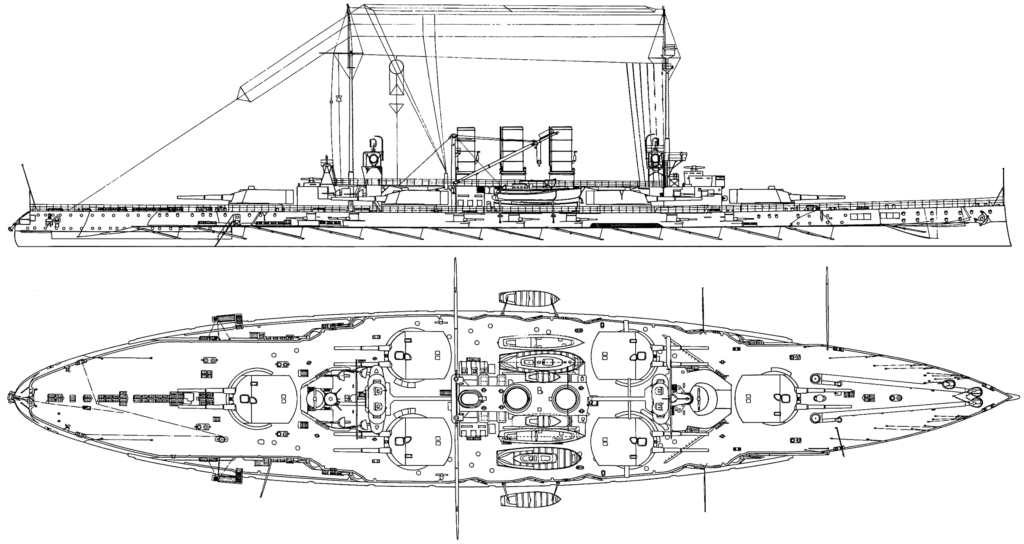
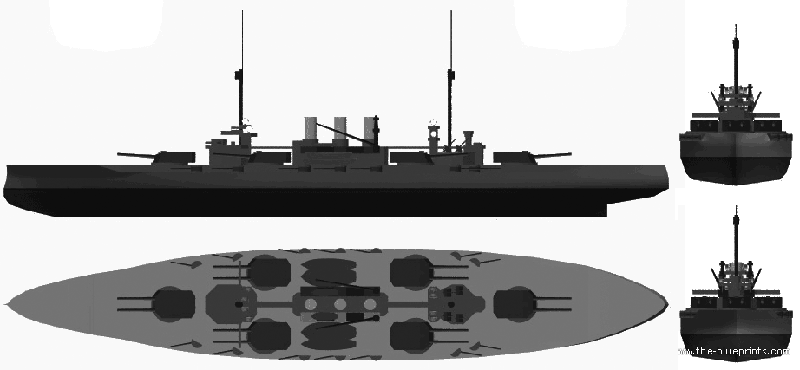

 Latest Facebook Entry -
Latest Facebook Entry -  X(Tweeter) Naval Encyclopedia's deck archive
X(Tweeter) Naval Encyclopedia's deck archive Instagram (@navalencyc)
Instagram (@navalencyc)





 French Navy
French Navy Royal Navy
Royal Navy Russian Navy
Russian Navy Armada Espanola
Armada Espanola Austrian Navy
Austrian Navy K.u.K. Kriegsmarine
K.u.K. Kriegsmarine Dansk Marine
Dansk Marine Nautiko Hellenon
Nautiko Hellenon Koninklije Marine 1870
Koninklije Marine 1870 Marinha do Brasil
Marinha do Brasil Osmanlı Donanması
Osmanlı Donanması Marina Do Peru
Marina Do Peru Marinha do Portugal
Marinha do Portugal Regia Marina 1870
Regia Marina 1870 Nihhon Kaigun 1870
Nihhon Kaigun 1870 Preußische Marine 1870
Preußische Marine 1870 Russkiy Flot 1870
Russkiy Flot 1870 Svenska marinen
Svenska marinen Søværnet
Søværnet Union Navy
Union Navy Confederate Navy
Confederate Navy Armada de Argentina
Armada de Argentina Imperial Chinese Navy
Imperial Chinese Navy Marinha do Portugal
Marinha do Portugal Mexico
Mexico Kaiserliche Marine
Kaiserliche Marine 1898 US Navy
1898 US Navy Sovietskiy Flot
Sovietskiy Flot Royal Canadian Navy
Royal Canadian Navy Royal Australian Navy
Royal Australian Navy RNZN Fleet
RNZN Fleet Chinese Navy 1937
Chinese Navy 1937 Kriegsmarine
Kriegsmarine Chilean Navy
Chilean Navy Danish Navy
Danish Navy Finnish Navy
Finnish Navy Hellenic Navy
Hellenic Navy Polish Navy
Polish Navy Romanian Navy
Romanian Navy Turkish Navy
Turkish Navy Royal Yugoslav Navy
Royal Yugoslav Navy Royal Thai Navy
Royal Thai Navy Minor Navies
Minor Navies Albania
Albania Austria
Austria Belgium
Belgium Columbia
Columbia Costa Rica
Costa Rica Cuba
Cuba Czechoslovakia
Czechoslovakia Dominican Republic
Dominican Republic Haiti
Haiti Hungary
Hungary Honduras
Honduras Estonia
Estonia Iceland
Iceland Eire
Eire Equador
Equador Iran
Iran Iraq
Iraq Latvia
Latvia Liberia
Liberia Lithuania
Lithuania Mandchukuo
Mandchukuo Morocco
Morocco Nicaragua
Nicaragua Persia
Persia San Salvador
San Salvador Sarawak
Sarawak Uruguay
Uruguay Venezuela
Venezuela Zanzibar
Zanzibar Warsaw Pact Navies
Warsaw Pact Navies Bulgaria
Bulgaria Hungary
Hungary

 Bundesmarine
Bundesmarine Dutch Navy
Dutch Navy Hellenic Navy
Hellenic Navy Marina Militare
Marina Militare Yugoslav Navy
Yugoslav Navy Chinese Navy
Chinese Navy Indian Navy
Indian Navy Indonesian Navy
Indonesian Navy JMSDF
JMSDF North Korean Navy
North Korean Navy Pakistani Navy
Pakistani Navy Philippines Navy
Philippines Navy ROKN
ROKN Rep. of Singapore Navy
Rep. of Singapore Navy Taiwanese Navy
Taiwanese Navy IDF Navy
IDF Navy Saudi Navy
Saudi Navy Royal New Zealand Navy
Royal New Zealand Navy Egyptian Navy
Egyptian Navy South African Navy
South African Navy






























 Ukrainian Navy
Ukrainian Navy dbodesign
dbodesign
you really need a proof reader. check main armament, heading says 28 cm, text gives the correct cms. for the 12″ gun.
Thx, fixed !
Volunteering ?